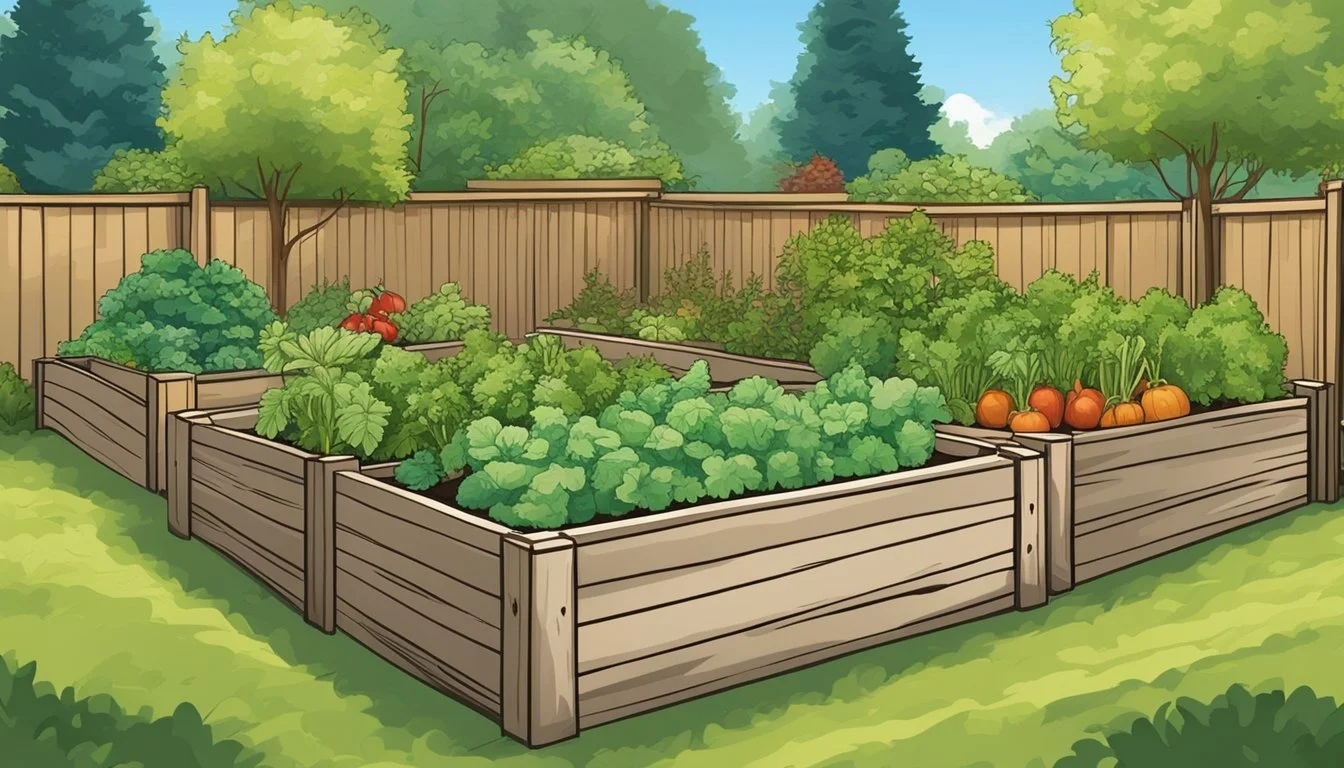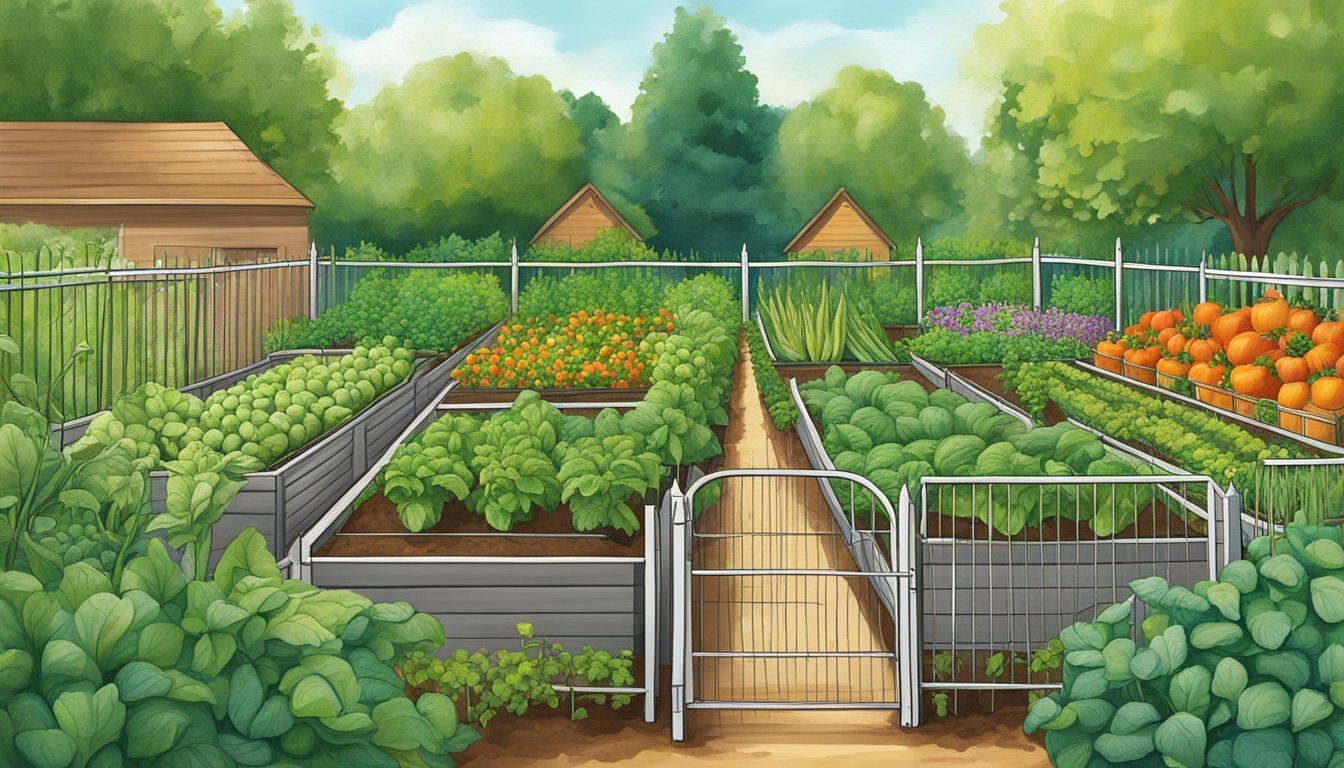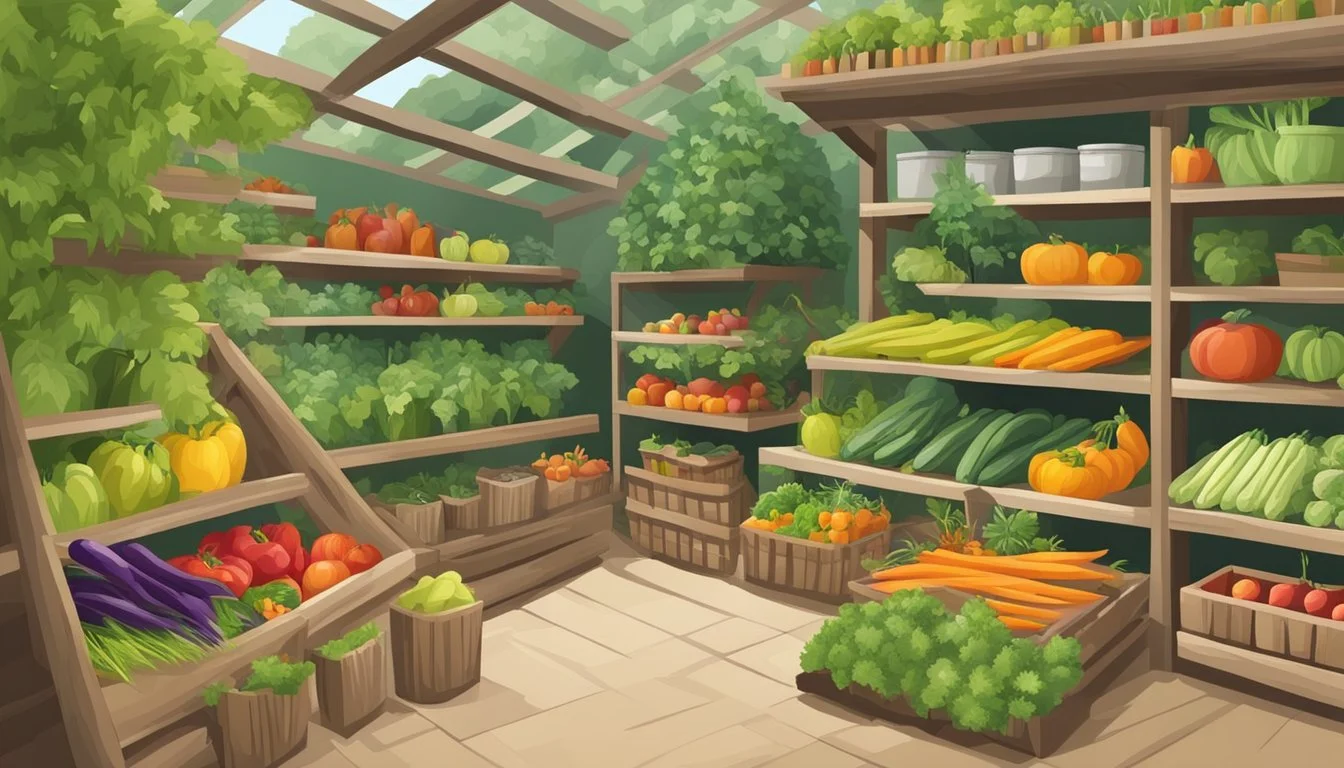Vegetable Gardening in Minnesota
A Practical Guide to Northern Cultivation
This Article is Part of Our Guide on Vegetable Gardening by State
Vegetable gardening in Minnesota offers a rewarding experience for those eager to cultivate their own fresh produce. Due to the state's distinct seasons, gardeners must adapt to the varying climatic conditions, from cold winters to hot, humid summers. The key to a successful harvest lies in understanding the local weather patterns and selecting crops that are well-suited to the region's growing conditions. Minnesota's prime vegetable gardening typically begins in late spring after the threat of frost has passed, extending into the fall when temperatures begin to cool.
Enthusiasts embarking on vegetable gardening must consider the state's unique challenges such as the potential for cool or wet spells, especially in spring and fall, which can affect tender plants. Planting in well-draining soil that receives ample sunlight is crucial for most vegetable types. Selection of the right vegetables is fundamental, and popular choices among Minnesotans include hardy greens like lettuce, root vegetables, and staple crops such as tomatoes and beans. Strategic planting times and techniques can lead to a bountiful yield that captures the essence of the growing season.
Access to local resources such as the University of Minnesota Extension and the Minnesota State Horticultural Society provides valuable insights into region-specific advice on when to plant various vegetables. These organizations offer a wealth of information on soil preparation, pest management, and other vital gardening practices. With such support and the proper approach, vegetable gardening in Minnesota can be a fruitful endeavor for both novice and experienced gardeners alike.
Understanding the Minnesota Climate
Minnesota’s climate presents distinct seasons, which significantly impact gardening activities. The state falls within the USDA Hardiness Zones 3 to 5, indicating a potential for cold weather that can influence how gardeners plan and care for their plants.
Spring in Minnesota typically starts with cold soil temperatures, necessitating patience from gardeners as they wait for the ground to warm. Early spring can still bring frost, creating a risky environment for tender, heat-loving vegetables.
Late spring sees a notable increase in soil warmth, allowing for a more diverse range of vegetables to be planted. The average growing season in Minnesota varies from region to region; in the southern parts, it can last up to 200 days, while the north may have fewer than 100 frost-free days.
Here’s a quick overview of the climate specifics in a typical Minnesota gardening calendar:
Season Soil Temperature Actionables Early Spring Cold Begin with cold-hardy crops Late Spring Warming Transition to a broader plant range
Gardeners need to understand their local hardiness zone and monitor soil temperature closely. This information helps in selecting suitable plant varieties that can thrive in Minnesota’s unique conditions, ensuring a successful and productive gardening endeavor.
Planning Your Vegetable Garden
Effective planning is crucial for a successful vegetable garden in Minnesota. It involves selecting the optimal site, preparing the soil, choosing suitable vegetables, and designing an efficient garden layout.
Selecting the Right Location
A garden should be positioned in an area that receives full sun—at least six hours of direct sunlight per day—as this is essential for most vegetables. The site must also be shielded from strong winds, which can damage plants and dry out soil. Proximity to a water source is important for convenient irrigation.
Determining Soil Conditions
The soil in Minnesota often requires amendment to promote healthy plant growth. Gardeners should ensure the soil is well-drained and rich in organic matter. Incorporating compost or manure can greatly improve soil fertility and texture. Conducting a soil test can reveal nutrient levels and pH balance, which are critical components in planning a vegetable garden.
Choosing Vegetables to Grow
Selection of crops should be based on Minnesota's climate. Hardy vegetables, such as lettuce, can withstand cool temperatures, making them suitable for early spring and fall planting. Gardeners should consider the length of the growing season when choosing other vegetables to ensure they can mature before the first frost.
Vegetables Ideal for Minnesota:
Lettuce
Kale
Carrots
Beetroot
Tomatoes (with a shorter growing season)
Garden Layout and Design
Garden design can vary, from traditional rows to raised beds, which offer excellent drainage and can extend the growing season. Proper spacing between plants is key to promote air circulation and reduce disease incidence. Vegetables should be grouped by their growing conditions and rotation should be planned to avoid soil nutrient depletion and pest build-up.
Preparing the Garden
Before seeds ever touch the soil, proper groundwork ensures a thriving vegetable garden in Minnesota's varied climate. Attention to soil quality, garden structure, and seedling care can set the stage for a bountiful harvest.
Soil Preparation and Amendment
Good soil preparation is crucial for a successful garden. In Minnesota, the soil often contains clay, which can be heavy and water-logged. Gardeners should conduct soil testing early to determine pH levels and nutrient content. Incorporating compost and organic matter is recommended to improve soil structure and fertility. Adding these amendments helps break up clay soil, promote drainage, and provide essential nutrients for plants.
Garden Beds and Containers
The choice between garden beds and containers depends on available space and personal preference. For individuals with limited space, containers offer a flexible and space-efficient option, and they are particularly beneficial for controlling soil quality. When using containers, ensure they have adequate drainage and are filled with a high-quality potting mix. For traditional garden beds, raised beds can enhance root development and prevent soil compaction.
Starting Seeds Indoors
For many vegetables, starting seeds indoors is a wise approach due to Minnesota's shorter growing season. Begin 6 to 8 weeks before the last frost date. Use sterilized containers and seed-starting mix to prevent disease. Provide the seedlings with sufficient light—either by a sunny window or with grow lights. This early start gives plants like tomatoes and peppers a head start before transplanting them outdoors.
Transplanting Seedlings Outdoors
When transplanting starts from indoors to the garden, it's important to harden off the seedlings by gradually exposing them to outdoor conditions. This reduces shock and improves their chances of successful acclimation. Transplant seedlings into well-amended soil, ideally on a cloudy day or in the late afternoon to minimize stress. Regular watering after transplanting is critical to help roots establish in their new environment.
Maintaining the Vegetable Garden
Maintaining a vegetable garden in Minnesota requires consistent effort. Gardeners must address specific needs such as proper watering, weed control, pest and disease management, and offering support to growing plants.
Watering Practices
In Minnesota's climate, watering the garden is crucial, especially during dry spells. Drip irrigation or a soaking hose is recommended to deliver water directly to the roots and minimize evaporation. Gardeners should aim for one inch of water per week, either from rainfall or manual watering.
Early Morning: Best time to water to reduce evaporation.
Water Deeply: Encourages deep root growth.
Mulching: Helps retain moisture in the soil.
Controlling Weeds
Weeds compete with vegetables for nutrients, light, and space and should be kept to a minimum.
Regular Mulching: Suppresses weed growth and maintains soil moisture.
Hand-pulling: Effective for immediate weed removal.
Cultivation: Should be shallow to prevent damage to vegetable roots.
Managing Pests and Diseases
Pests and diseases can swiftly compromise a garden.
Regular Inspection: Early detection is key.
Natural Predators: Encourage beneficial insects like ladybugs.
Organic Pesticides: Use as a last resort and follow label instructions.
Diseases should be managed by rotating crops and removing infected plants.
Support Structures for Plants
Supports are essential for certain types of vegetables to thrive.
Trellises: Ideal for vining crops like cucumbers and beans.
Stakes: Provide support for tomatoes and peppers.
Cages: Help maintain plant structure and improve air circulation.
Use of vertical gardening practices not only saves space but also can reduce disease incidence by improving air flow around the plants.
The Best Vegetables to Grow in Minnesota
Minnesota's climate offers unique opportunities for vegetable gardeners, with a range of vegetables that thrive in its varied seasons. Hearty greens and cold-tolerant root vegetables perform well, as do warm-season crops like tomatoes and squash given proper care.
Leafy Greens and Lettuce
Cool temperatures in Minnesota are conducive to growing a variety of leafy greens. Kale tops the list as a cold-hardy and nutritious choice, thriving even through frosty weather. Lettuce is another excellent selection, providing fresh salads throughout the spring and fall. Spinach and cabbage also offer robust growth in Minnesota's cooler climate.
Kale: Hardy and nutritious
Lettuce: Provides fresh salads in spring and fall
Spinach: Grows well in cool weather
Cabbage: Suitable for Minnesota's climate
Root Vegetables
Root vegetables are favorites among Minnesota gardeners due to their resilience and ability to store well. Carrots and radishes are simple to grow and require little maintenance. Beets, with their earthy sweetness, are also ideal for Minnesota soils. Onions can be harvested at summer's end, while potatoes yield a substantial crop well suited to storage:
Carrots: Low maintenance, sweet flavor
Radishes: Quick to mature, peppery taste
Beets: Earthy and sweet, stores well
Onions: End of summer harvest, robust flavor
Potatoes: Substantial yield, stores excellently
Summer and Winter Squash
Squash varieties are distinguished by the seasons they grow best in. Summer squash, including zucchini and yellow squash, matures quickly and can be harvested throughout the season. Winter squash, like pumpkins and butternut squash, matures later and stores well into the winter months.
Summer Squash: Fast-maturing, continuous harvest
Winter Squash: Late maturity, excellent for storage
Pumpkins: Ideal for fall harvest and decoration
Cultivating Tomatoes and Peppers
Tomatoes and peppers require warmth and thus should be planted after the last frost has passed. They thrive in Minnesota's summer heat, with tomatoes offering a variety of types, from cherry to beefsteak. Peppers vary from sweet bell to spicy varieties, allowing for a diverse crop. Both require staking or caging for support as they grow.
Tomatoes: Diverse varieties, need warmth
Peppers: From sweet to spicy, require support
Cucumbers and beans, while not highlighted in the subsections, are additional low-maintenance vegetables that grow well in Minnesota's climate. They are often planted in succession to ensure a continuous harvest.
By focusing on these suitable vegetable selections, Minnesota gardeners can enjoy a bountiful and satisfying gardening season.
Harvesting and Storing Your Harvest
Proper techniques in harvesting and storing vegetables are crucial for gardeners to maintain the quality and increase the longevity of their harvest. Factors such as timing, handling, and storage conditions play significant roles in the success of a garden's yield.
Picking Vegetables at Peak Ripeness
Timing is everything when harvesting vegetables. A gardener should monitor their crops closely and understand the signs of peak ripeness for each type. Tomatoes, for instance, should be plucked when they're brightly colored and firm to the touch, whereas sweet corn should be harvested when the kernels are full and milky.
Leafy Greens: Harvest leaves from the outside, sparing the inner foliage to encourage further growth.
Root Vegetables: Gentle loosening of the soil can help prevent damage to the vegetable during extraction.
Post-Harvest Handling
Once harvested, the vegetables should be handled with care to prevent bruising. Removing soil and any pests is the first step, often followed by a gentle washing if necessary. For many vegetables, it's also important to:
Trim off any excess leaves to minimize moisture loss.
Dry properly before storage to reduce the risk of mold or rot.
Cold and Dry Conditions (32-40°F and 65% relative humidity) are best for storage of items like onions and garlic, while Cold and Moist Conditions (32-40°F and 95% relative humidity) cater to maintaining the quality of leafy greens and crisp root crops.
Extending the Season with Cold Storage
To extend the freshness of the produce, utilizing varied storage methods allows a gardener to enjoy their vegetables well beyond the growing season.
Root Cellars: Provide the ideal cold and humid conditions for crops like beets and carrots.
Refrigeration: Suitable for short-term storage of sensitive vegetables.
Freezing: A viable option for long-term preservation while retaining nutritional quality, particularly for vegetables like green beans that freeze well.
Accurate labeling and monitoring of stored vegetables ensure that one enjoys the freshest produce throughout the colder months. Gardeners in Minnesota can thus capitalize on their efforts and relish in the taste of their home-grown vegetables all year round.
Resources for Minnesota Gardeners
For those with a keen interest in cultivating their own vegetables, Minnesota offers a wealth of resources. Gardeners have access to various support channels ranging from local garden centers to extensive online networks and educational programs.
Local Garden Centers and Nurseries
Local garden centers and nurseries are invaluable for Minnesota's gardeners, providing a selection of plants adapted to the Midwest climate. These establishments typically offer a variety of native plant species that thrive in Minnesota's unique conditions.
Knowledgeable Staff: They employ staff with regional expertise who can offer tailored gardening advice.
Supplies and Tools: Gardeners can find quality soils, fertilizers, tools, and vegetable seedlings suited for their yard and garden needs.
Online Gardening Communities
Online gardening communities provide a platform for gardeners to connect, share experiences, and seek advice. They are especially helpful for those looking to learn more about vegetable gardening in Minnesota's climate.
Discussion Forums: Platforms such as social media groups and gardening forums offer a place to discuss Midwest gardening tips and tricks.
Resource-Sharing: These communities often share resources such as planting guides, instructional videos, and webinars.
University of Minnesota Extension
The University of Minnesota Extension is a critical resource for gardeners in Minnesota, bringing research-based knowledge directly to the public.
Educational Resources: They offer courses and publications on topics like soil preparation, planting strategies, and managing pests and diseases.
Seasonal Support: Minnesotan gardeners can take advantage of year-round programs designed to extend the growing season and improve harvest yields.




